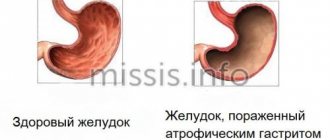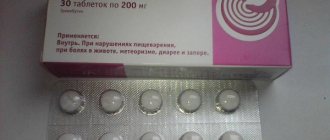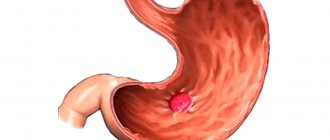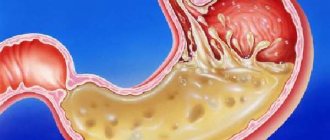Atrophic gastritis is a dangerous and insidious type of chronic gastritis. The fact is that with this diagnosis, the glands responsible for the production of gastric juice atrophy. During the course of the disease, they change and die, and new tissues are formed in their place, and this process is rather poorly controlled by the body. And it is these new cells that very often turn into cancer cells.
Atrophic gastritis can occur with either increased, normal or decreased acidity of gastric juice. Today we will look at how to treat atrophic gastritis with low acidity.
Causes of atrophic gastritis with low acidity
Most often, the appearance of this disease is associated with infection of the body by the bacterium Helicobacter pylori. Gastritis with low acidity is less common than with high acidity. It is more typical for people of mature age, prone to violations of the diet and quality of nutrition, as well as bad habits. However, you should be aware that the type of disease with high acidity can over time transform into a form with low acidity. This happens precisely because of atrophic processes on the gastric mucosa. Excess hydrochloric acid destroys the walls of the stomach with the glands located on them, which cease to function, the acidity decreases first to normal, and then below normal.
Low acidity - what is it?
The most important component of gastric juice is hydrochloric acid, which, in fact, is responsible for the digestion of food. Its concentration in the gastric juice is an indicator of acidity. If it is increased or decreased, the stomach functions differently, and an unpleasant and even dangerous disease appears - gastritis. If left untreated, the form of the disease becomes chronic.
If we are talking about atrophic gastritis, then low acidity is formed due to atrophy of the glands, which, as the disease progresses, lose their functionality, producing less hydrochloric acid and enzymes.
Let's consider a number of causes of this disease:
- eating disorders (frequent alternation of states of hunger and overeating, snacking on the go, non-compliance with the nutrition schedule);
- snacking on dry, unhealthy foods (fatty, spicy, smoked, etc.);
- bad habits (smoking, alcohol abuse, especially on an empty stomach);
- regular stress;
- uncontrolled use of medications;
- untreated gastritis;
- non-compliance with the diet and recommendations of the attending physician in the presence of any gastrointestinal diseases;
- the presence of chronic diseases of other organs (liver, kidneys, pancreas and thyroid glands, etc.).
Reasons for development
Disruption of the functioning of the digestive organ occurs under the influence of external and internal factors on the body. In order to prevent the occurrence of the disease, you should study the causes of the disease and try to eliminate them.
Provoking factors for the development of gastritis with reduced secretion may be the following reasons:
- Poor nutrition (violation of the regime, consumption of spicy or rough foods).
- Violation of circulatory processes due to heart disease.
- Pathologies of the respiratory system, in which the body does not receive enough oxygen.
- Abuse of strong alcoholic drinks and a decrease in the body's defenses against the background of autoimmune diseases.
- Metabolic disorders (gout, metabolic disorders).
- Diseases of the endocrine system.
- Associated dysfunctions and disorders of the gastrointestinal tract.
Gastritis with reduced secretion develops against the background of two main reasons:
- Long-term progression of Helicobacter pylori infection, in the absence of therapeutic measures. Pathogenic microorganisms that provoke an inflammatory process in the gastric mucosa affect not only the antrum of the stomach, but also the body. At this time, atrophic changes in the gastric mucosa predominate and diffuse atrophic pangastritis develops.
- Autoimmune gastritis. Its most characteristic feature is the rapid development of diffuse atrophy of the gastric mucosa and damage to the main gastric glands located in the body and fundus of the stomach.
We recommend: Symptoms of heartburn
Clinicians believe that the development of chronic gastritis with reduced secretory function also occurs due to toxic poisoning and chemical burns of the stomach. Mental and nervous stress can lead to the progression of the disease. The presence of congenital anomalies in the functioning or structure of the gastrointestinal tract plays an important role.
Features of atrophic gastritis
The process of healthy digestion involves gastric enzymes that function in an acidic environment. After their influence, food moves from the acid-forming part of the stomach to the antrum, where the acid is neutralized. If some of the glands that produce hydrochloric acid are atrophied, the acidity in the stomach decreases, which contributes to digestive disorders. For example, with low acidity, the process of protein breakdown is disrupted and the absorption of vitamins and minerals is significantly reduced.
In addition, the lack of the required amount of hydrochloric acid lengthens the digestion process, which is why undigested food begins to rot right in the stomach. This process promotes the proliferation of pathogenic bacteria, which leads to new gastrointestinal diseases.
This type of gastritis is characterized by minor inflammation. Atrophic processes predominate over inflammatory processes, as the name suggests.
Atrophied mucosal cells are replaced by another type of cells - connective cells. They do not produce substances necessary for digestion, which reduces the quality of this process. In addition, these new cells are prone to becoming cancerous.
The degrees of atrophy are divided as follows:
- mild, in which about 10% of the glands are atrophied;
- average, cell atrophy in which ranges from 10 to 20%;
- severe, in which more than 20% of the glands are atrophied.
In the absence of timely treatment, a condition occurs in which the glands do not produce either the main digestive gastric enzyme (pepsin) or hydrochloric acid. This condition is called achylia or achylic gastritis. Its main feature is extremely difficult digestion, because the stomach cannot cope with its functions. Undigested food stagnates, causing symptoms such as “rotten” belching, nausea and vomiting, heaviness, alternating constipation and diarrhea, loss of appetite and body weight. As mentioned above, pathogenic bacteria multiply intensively in the stomach.
Important! If you find any signs of gastritis, consult a doctor as soon as possible!
Symptoms of low stomach acidity can be determined independently
The most typical symptom of low stomach acidity is putrid breath and belching that smells like a rotten egg.
Acid in the stomach has an antiseptic, bactericidal effect, and if there is a lack of acid in the gastric secretion, the protective mechanisms are significantly weakened, so microorganisms that change its microflora often enter the intestines of a person suffering from anacid gastritis. Therefore, intestinal disorders such as constipation or diarrhea are common symptoms of low stomach acid.
Persistent constipation can also be caused by decreased gastrointestinal motility due to lack of acid, and diet and various methods of dealing with constipation do not eliminate this disorder.
Fermentation processes in the intestines lead to pain from the accumulation of gases in the intestines, bloating, bloating, flatulence, and rumbling.
Incomplete digestion of proteins creates a concentration of breakdown products in the stomach, which have a toxic effect on the entire body, reducing immunity. And when the body’s resistance drops, various pathological processes begin in any organ or system, most often various mycoses progress - fungal infections of the mucous membranes, skin, nails, a person more often suffers from viral and other diseases, and oncological diseases may occur.
In addition to disrupting the process of protein breakdown, all vitamins and minerals also begin to be poorly absorbed in the intestines:
- Due to a lack of vitamins, hair becomes dry and brittle, nails peel and break, the skin of the hands and face becomes dry.
- Anemia - iron deficiency anemia is one of the indirect symptoms of low acidity in the stomach, in combination with atrophic gastritis is called Addison-Biermer disease. With autoimmune gastritis, B12 deficiency anemia develops.
- Acne and dilated blood vessels on the nose and cheeks also often accompany a decrease in stomach acidity.
One of the symptoms of low acidity is the presence of undigested food debris in the stool.
After eating, patients often feel a feeling of heaviness, fullness, heartburn, and sometimes a dull pain in the stomach immediately after eating or 20 minutes after.
When the concentration of acid in the stomach decreases, important enzymes such as pepsin remain inactive, therefore the process of protein digestion worsens or is significantly weakened. And this has a very negative effect on the entire body; an active fermentation process begins in the intestines:
Symptoms of atrophic gastritis
At the first stages the disease is asymptomatic, but as it progresses the following symptoms appear:
- aching pain in different areas of the abdomen that occurs after eating;
- heaviness in the stomach after eating, even after light snacks;
- bloating;
- flatulence;
- “rotten” belching;
- heartburn;
- desire to eat something sour;
- stool disorders (alternating constipation and diarrhea);
- whitish coating on the tongue;
- decreased appetite;
- weight loss;
- bloating;
- general weakness.
In addition to these main symptoms, secondary symptoms that arise due to a lack of proteins, vitamins and minerals can be divided into a separate group:
- fast fatiguability;
- anemia;
- milk intolerance;
- increased fragility of nails and hair;
- dry skin;
- low pressure;
- tachycardia;
- weight loss.
Diagnosis of atrophic gastritis with low acidity
Based on symptoms and external signs, the atrophic form of gastritis is almost impossible to distinguish from another, therefore tests and instrumental diagnostics are necessary, which include:
- FGS with a biopsy of the affected mucosa, which most effectively determines the type of gastritis;
- determining the acidity level using a probe or a special capsule;
- X-ray of the stomach and duodenum;
- Ultrasound of the gastrointestinal tract.
A blood test can determine whether the patient's stomach contains the bacterium Helicobacter pylori.
What diseases cause low acidity?
If a person constantly exhibits the symptoms of low stomach acidity described above, and the study confirms that the acidity is low or zero, then this is fraught with the development of the following diseases:
- stomach cancer;
- antacid gastritis or gastroduodenitis with low acidity. It should be taken into account, if anacid gastritis , that this is a condition when the acidity in the stomach is more than 5 pH. Signs of low stomach acidity in this condition are accompanied by constant discomfort and pain in the stomach area.
determine stomach ulcers , gastritis and other pathological processes after examination.
Treatment of gastritis with low acidity
For atrophic gastritis with low acidity, it is important to follow a complex of treatment. It includes a special therapeutic diet, drug therapy and additional treatment with folk remedies. This entire complex must be prescribed by the attending gastroenterologist.
Important! Treatment of atrophic gastritis is carried out under the supervision of a specialist: a gastroenterologist.
Drug treatment
Depending on the need, the following drugs are used:
- Antibiotics and anti-Helicobacter pylori agents are used for infection with the bacterium Helicobacter pylori (Metronidazole, Clarithromycin, Tinidazole, Amoxicillin, De-Nol, Ulcavis).
- Painkillers (“No-Shpa”, “Drotaverine”, “Papaverine”).
- Regenerating, enveloping and protecting the mucous membrane (De-Nol, Ulkavis, Almagel, Vikalin, Solcoseryl).
- Normalizing motor skills (“Trimedat”).
- Reducing (Omez, Omeprazole) or increasing (Acidin-Pepsin, Limontar, Etimazol) acidity.
- Enzyme replacement therapy drugs (Creon, Pancreatin, Mezim, Festal).
Treatment with folk remedies
To combat this type of gastritis, the following folk remedies are used:
- potato (relieves pain) and cabbage (heals mucous membranes) juices;
- decoction of flax seeds (well protects damaged mucous membranes);
- honey;
- green tea on an empty stomach;
- applesauce with lemon and honey on an empty stomach;
- infusion of parsley roots or plantain leaves;
- rosehip decoction;
- horseradish root;
- chamomile decoction with honey.
Many patients are interested in whether it is possible to completely cure atrophic gastritis? The answer is clear: this type of gastritis cannot be completely cured, but with proper and timely treatment, the atrophic processes can be stopped.
Additional treatment and healing methods
In addition to the above methods, treatment with mineral waters is common, which is carried out both in sanatoriums and at home. The attending physician selects the appropriate type, temperature and time of intake (before or after meals) of mineral water. Such properly selected treatment, as a rule, has no contraindications.
In addition, patients with this diagnosis are advised to engage in certain physical activity, as it stimulates the production of hydrochloric acid. Breathing exercises, walks in the fresh air, and gymnastic exercises that do not provide significant stress are recommended. All exercises are done to the best of your ability, without overload or sudden movements. They should not be performed in the acute stage or when feeling discomfort.
Important! There should be at least 1.5 hours between physical exercise (except for walking) and meals.
Causes
The exact cause of the loss of the ability of the secretory apparatus of the body of the stomach to produce gastric juice, the main component of which is hydrochloric acid, is unknown. The spread of the disease among close relatives led to the belief in the hereditary inferiority of epithelial cells. As a result, they cannot withstand the effects of food, die and recover very poorly.
Another possibility is a phase of increased acidity and overirritation of the epithelium, subsequent inflammation of the stomach. If left untreated, the process becomes irreversible. And with the death of functioning glandular cells, acidity decreases. Some factors have additional negative effects.
These include:
- regular violation of the diet, fasting, low-calorie diets, long breaks in food, snacks on the run and dry food;
- passion for fatty, fried, meat foods, spicy dishes, spices, seasonings, sweets. This composition is too difficult for digestion and leads to stomach overload;
- forced long-term use of medications that have a negative effect on the stomach (corticosteroids, non-hormonal anti-inflammatory drugs, cytostatics, antibacterials and containing acetylsalicylic acid);
- accidental or intentional poisoning with toxic substances, acids, alkalis;
- allergic reaction to food;
- endocrine diseases of the thyroid gland,
- neurotic disorders, stress;
- impaired immunity;
- infection by pathogenic bacteria, fungi, viruses, parasites;
- chronic pathology of other organs of the digestive system (liver, intestines, pancreas, gall bladder);
- the presence of foci of chronic infection in the body (sinusitis, tonsillitis, carious teeth, rheumatism, kidney and liver failure);
- violation of the regime, diet, premature refusal of medications in the treatment of acute gastritis;
- negative emotional environment during meals.
These factors not only reduce acid production in the stomach, but also contribute to the development of the atrophic process.
Alcohol abuse (including beer), nicotine intake through smoking has an aggressive effect on the production of gastric juice
Therapeutic diet and menu for atrophic gastritis
Basic principles of the diet:
- follow a diet (regular split meals 5-6 times a day, which will reduce the load on the stomach);
- do not overeat;
- eat only permitted foods and dishes;
- consume only warm food and drinks (not too hot and not too cold);
- completely eliminate prohibited foods and dishes (fried, salted, smoked, rough, etc. food, alcohol, soda, fast food);
- to refuse from bad habits;
- Avoid stress if possible.
Allowed and recommended foods and dishes
We recommend foods and dishes that will not injure the mucous membranes and give a feeling of heaviness. They should be easy to digest and at the same time stimulate the digestive glands. Such products and dishes include:
- lean varieties of meat and fish without cartilage and films, boiled or steamed;
- low-fat meat and fish broths;
- steamed or boiled vegetables (potatoes, cauliflower, carrots, beets, etc.);
- fresh vegetables, fruits and berries;
- fresh fruit juices;
- jelly, compotes, jellies, decoctions of fruits and berries;
- vegetable puree soups with cereals and pasta;
- yesterday's unsatisfying baked goods;
- some sweets: marmalade, pastille, marshmallows, honey;
- porridge (except wheat and pearl barley) in low-fat broth or a mixture of milk and water;
- low-fat boiled sausages and boiled sausages;
- kefir, cottage cheese and cottage cheese dishes;
- egg dishes, except fried ones.
Prohibited foods and dishes
You should not eat food that takes a long time to digest, irritates the stomach and is prone to fermentation, without stimulating the production of gastric juice:
- fatty, smoked, salted, fried, canned, etc.;
- most vegetables that have not been cooked;
- fresh bread and baked goods, including high-fat confectionery products;
- whole milk and fatty fermented milk products;
- legumes in any form;
- carbonated drinks.
Sample menu
This menu is approximate and may vary depending on patient preferences.
- 1st breakfast: slimy oatmeal or rice porridge and a boiled egg, weak tea or chicory with a small amount of milk;
- 2nd breakfast: cottage cheese casserole or fruit jelly, tea, compote, oatmeal or rosehip drink;
- lunch: vegetable puree soup with meatballs and pasta or stewed vegetables with lean fish or a piece of chicken breast, tea or dried fruit compote;
- afternoon snack: a glass of kefir with bread, a baked apple or cottage cheese casserole, jelly or oatmeal broth.
- Dinner: stewed, steamed or boiled vegetables or boiled porridge (buckwheat, rice) with a piece of fish or chicken, jelly, rosehip drink or oatmeal broth.
- Before bed: kefir, oatmeal broth or jelly.
Atrophic gastritis in women, general concepts:
Atrophic gastritis in women is recognized as a precancerous disease. Therefore, it will not hurt anyone to learn the basics of the disease. This is especially necessary for those over 50. What our stomach has not endured in life is now payback.
The name gastritis speaks for itself. With atrophic gastritis, in addition to inflammation, the number of normally functioning cells is seriously reduced.
The cells of the stomach gradually change, their structure is disrupted, and then gradual death occurs. The function of enzyme production and absorption changes sharply. Nutrients do not reach the body in the form they need.
The mucous layer of the stomach is significantly reduced. The production of gastric juice is reduced, food is poorly processed and absorbed. Death of the normal walls of the stomach occurs and is replaced by scars.
It’s simple to say - the gastric mucosa has worn out, become thin, and almost doesn’t do its job. All folds of the stomach straighten and become thin.
Why does our stomach change so much? What accompanies this? Medicine does not answer us exactly; there are only indirect reasons for this.
Prevention of atrophic gastritis
As with any disease, with gastritis it is very important to prevent the disease as a whole and its relapses. The prevention complex includes:
- regular healthy eating;
- rejection of bad habits;
- healthy lifestyle;
- sufficient physical activity;
- visiting a doctor at the first signs of gastrointestinal disease;
- in case of diagnosis, annual examination;
- compliance with medical recommendations.
As you can see, even such a serious diagnosis as atrophic gastritis is a reason not to lose heart, but to start treatment. The earlier the intervention occurs during the course of the disease, the easier and more effective the treatment will be. Be healthy!










